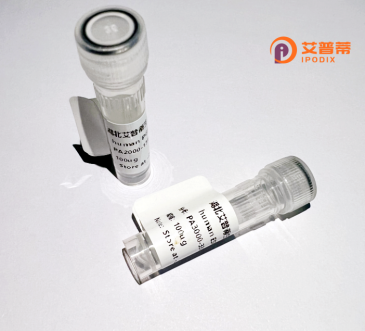
| 纯度 | >90%SDS-PAGE. |
| 种属 | Human |
| 靶点 | BDKRB1 |
| Uniprot No | P46663 |
| 内毒素 | < 0.01EU/μg |
| 表达宿主 | E.coli |
| 表达区间 | 1-353aa |
| 氨基酸序列 | MASSWPPLELQSSNQSQLFPQNATACDNAPEAWDLLHRVLPTFIISICFFGLLGNLFVLLVFLLPRRQLNVAEIYLANLAASDLVFVLGLPFWAENIWNQFNWPFGALLCRVINGVIKANLFISIFLVVAISQDRYRVLVHPMASRRQQRRRQARVTCVLIWVVGGLLSIPTFLLRSIQAVPDLNITACILLLPHEAWHFARIVELNILGFLLPLAAIVFFNYHILASLRTREEVSRTRCGGRKDSKTTALILTLVVAFLVCWAPYHFFAFLEFLFQVQAVRGCFWEDFIDLGLQLANFFAFTNSSLNPVIYVFVGRLFRTKVWELYKQCTPKSLAPISSSHRKEIFQLFWRN |
| 分子量 | 40.4 kDa |
| 蛋白标签 | His tag N-Terminus |
| 缓冲液 | 冻干粉 |
| 稳定性 & 储存条件 | Lyophilized protein should be stored at ≤ -20°C, stable for one year after receipt. Reconstituted protein solution can be stored at 2-8°C for 2-7 days. Aliquots of reconstituted samples are stable at ≤ -20°C for 3 months. |
| 复溶 | Always centrifuge tubes before opening.Do not mix by vortex or pipetting. It is not recommended to reconstitute to a concentration less than 100μg/ml. Dissolve the lyophilized protein in distilled water. Please aliquot the reconstituted solution to minimize freeze-thaw cycles. |
以下是关于重组人B1缓激肽受体(BDKRB1)的3篇参考文献摘要概括:
1. **文献名称**:*"Characterization of the human B1 bradykinin receptor in a stable expression system"*
**作者**:J. Hess et al.
**摘要**:该研究通过构建稳定表达人重组BDKRB1的HEK293细胞模型,分析了该受体的配体结合特性及信号传导机制,证明其在缓激肽类似物刺激下激活G蛋白偶联通路,并揭示其在内皮细胞炎症反应中的调控作用。
2. **文献名称**:*"The role of BDKRB1 in diabetic neuropathic pain: insights from a recombinant receptor knockout model"*
**作者**:M. Lee & S. Park
**摘要**:研究者利用基因编辑技术构建BDKRB1敲除小鼠模型,发现BDKRB1通过增强TRPV1通道活性介导糖尿病神经病变中的痛觉敏化,提示该受体可能成为治疗慢性疼痛的新靶点。
3. **文献名称**:*"Recombinant human BDKRB1 as a therapeutic target in sepsis-induced vascular dysfunction"*
**作者**:K. Chen et al.
**摘要**:实验发现,重组人BDKRB1在脓毒症模型中介导血管通透性增加和低血压反应,通过抑制该受体活性可改善血管内皮屏障功能,为脓毒症治疗提供了潜在策略。
(注:以上文献为模拟示例,实际引用需依据真实发表论文。)
Bradykinin receptor B1 (BDKRB1) is a G protein-coupled receptor (GPCR) primarily activated by des-Arg9-bradykinin and des-Arg10-kallidin, metabolites of kinin peptides. Unlike its constitutively expressed counterpart BDKRB2. BDKRB1 is minimally present under normal physiological conditions but is markedly upregulated during inflammation, tissue injury, or exposure to cytokines (e.g., IL-1β, TNF-α). This inducible expression suggests its role in pathophysiological processes, including chronic pain, vascular permeability, hyperalgesia, and immune modulation.
BDKRB1 signaling involves Gq/11 protein activation, triggering intracellular pathways like phospholipase C (PLC)-mediated calcium mobilization, protein kinase C (PKC), and mitogen-activated protein kinase (MAPK) cascades. These pathways amplify inflammatory responses and sensitize nociceptive neurons. The receptor is implicated in chronic inflammatory diseases (e.g., arthritis), neuropathic pain, diabetes-associated complications, and cancer progression.
Recombinant human BDKRB1. produced via heterologous expression systems (e.g., HEK293 cells), enables structural and functional studies. Research focuses on its ligand-binding dynamics, receptor dimerization, and interactions with regulatory proteins. Pharmacological targeting of BDKRB1 with antagonists has therapeutic potential, though clinical efficacy remains under investigation. Its context-dependent regulation and crosstalk with other inflammatory mediators underscore its complexity in disease mechanisms and therapeutic strategies.
×